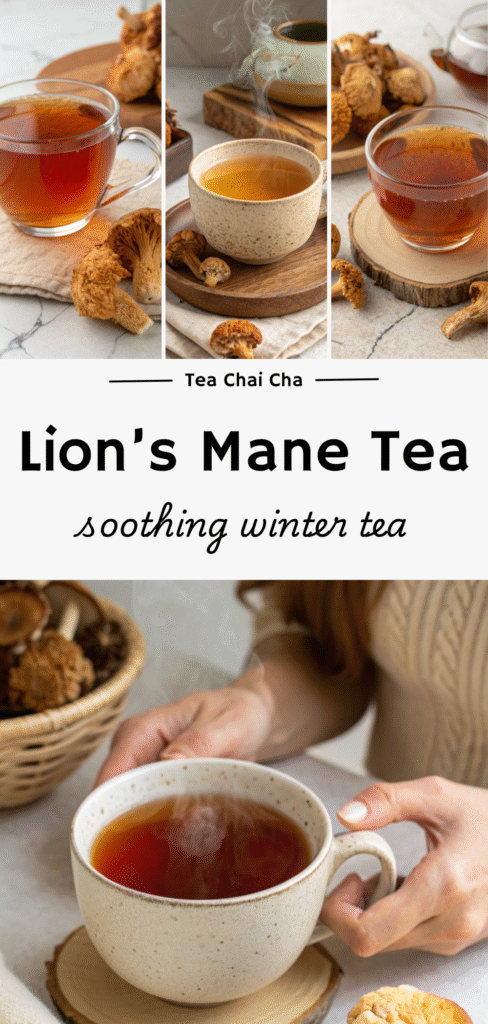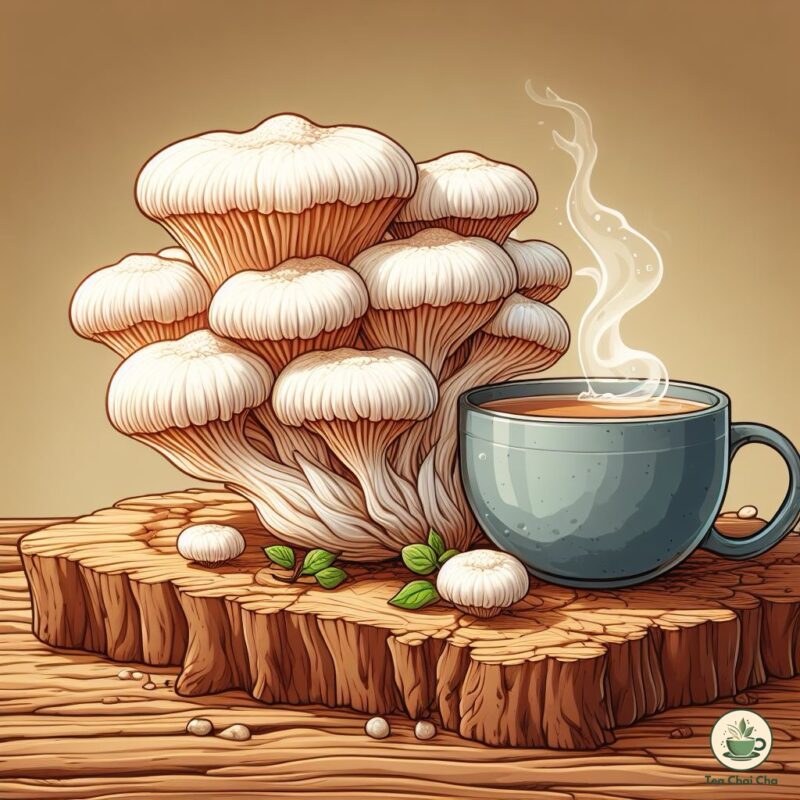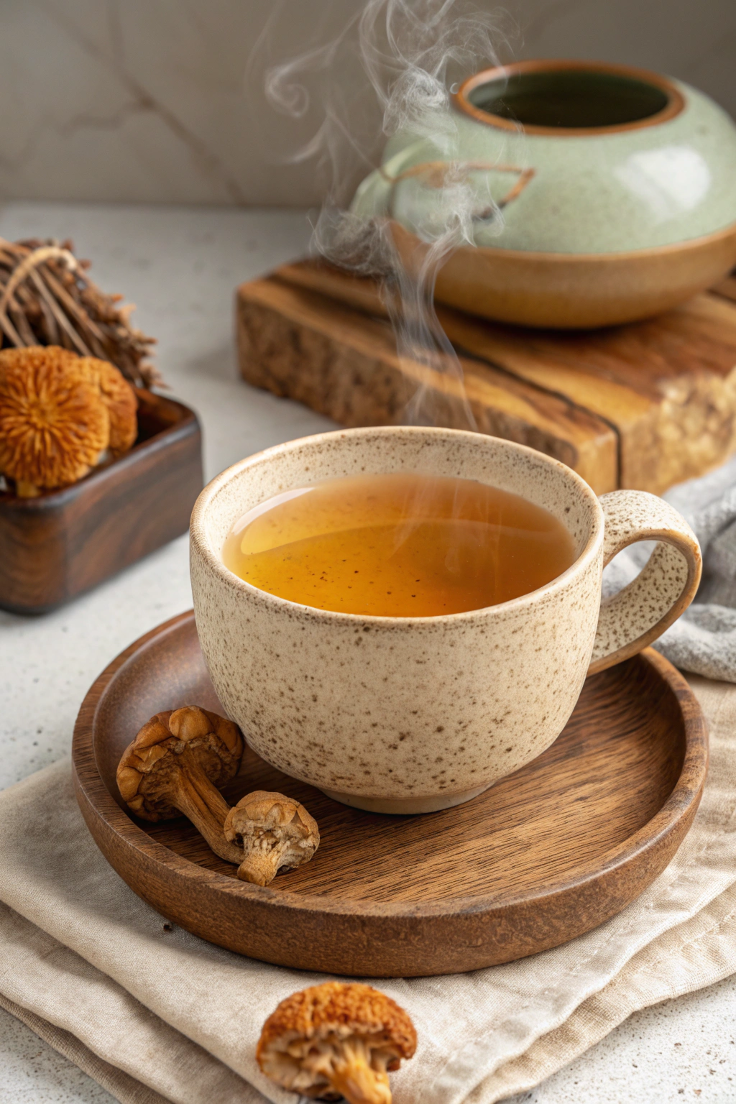Have you heard the whispers about lion’s mane being a brain’s best friend?
Obviously you did and even bought or are contemplating getting your hands on lion’s mane mushrooms!
But it would be a big trouble if you got a bag of lion’s mane mushrooms, and not know the answer to this, “How in the world do I turn these into tea?“
Well, I have a quick recipe and simple procedure to help you make lion’s mane tea in no time!

What Is a Lion’s Mane Mushroom?
Lion’s Mane Mushroom is a fungus.
Now, if you’re into the whole scientific tag, here it is: Hericium erinaceus.
Not your typical cap-and-stem deal – it’s more like a shaggy, white globe.
Why the name?
Well, it earned the title because, yup, it looks like a lion’s mane.
-> History Bites
Lion’s mane isn’t some recent discovery.
It’s been part of traditional medicine in Asia for a hot minute.
China, Japan – they’ve been using it for centuries.
-> Natural Habitat
Lion’s mane mushrooms aren’t the city-dwelling type.
You’ll find these guys not hanging out in grocery stores but chilling on trees.
Yeah, they grow on hardwoods, often seen on dead or decaying wood in forests.
-> Global Nomad
Lion’s mane isn’t picky about its address.
You can spot it in North America, Europe, and Asia.
It’s like a globe-trotting fungus, popping up in different corners of the world.
So, if you’re wondering whether this mushroom is a local or a world traveler, it’s the latter.
-> Edible Oddity
Now, you might be wondering, “Can I munch on this?” Yep, you can.
People toss it in stir-fries or gobble it up like a steak substitute.
It’s not your average mushroom taste – some say it’s got a seafood vibe.
If you’re into trying edible oddities, lion’s mane might be your jam.
-> Brainy Reputation
People are buzzing about lion’s mane because some folks believe it’s a brain booster.
Like a natural nootropic.
It’s got this reputation for potentially enhancing your cognitive game.
If you’re into the idea of a smart shroom, lion’s mane might catch your attention.
-> Health Hype
Health trends can be a mixed bag.
But lion’s mane isn’t just another fad.
Some studies hint at it having antioxidant and anti-inflammatory properties.
If you’re on the lookout for something that might bring a health punch to the table, lion’s mane is making waves in that department.
-> Mushroom Tea Twist
So, why are we talking about this fungus in the context of tea?
Well, some people (tea drinkers like you and me!) prefer brewing lion’s mane mushroom tea.
It’s not your everyday Earl Grey, but if you’re up for a different kind of steeping adventure, lion’s mane might be your ticket to a unique cuppa with potential brain-boosting perks.
How to Make Lion’s Mane Mushroom Tea
Here’s the lowdown on crafting a cup of brain-boosting goodness in the form of lion’s mane mushroom tea.
Pay attention; it’s as straightforward as it gets.
Step 1: Gather Your Troops
Get yourself a handful of dried lion’s mane mushrooms.
None of that fresh stuff – we’re talking dried and ready to roll.
You’ll need about 1 to 2 tablespoons.
Now, reach for that water kettle of yours.
No need to be fancy; a regular one works just fine.
Step 2: Chop and Slice
Time to wield that knife. Chop the dried lion’s mane mushrooms into small bits.
No need to channel your inner culinary artist here.
Just give them a good rough chop.
Step 3: Boiling Point
Bring about 2 cups of water to a boil. Simple, right?
Toss in those chopped lion’s mane pieces.
Let it simmer for 10 to 15 minutes.
Just long enough to let the magic happen.
Step 4: Strain the Squad
Grab a fine mesh strainer or cheesecloth.
Strain out those mushroom bits like a boss.
We want pure lion’s mane elixir, no floaty bits.
Step 5: Sip and Enjoy
You’ve made it!
Pour that liquid gold into your favorite mug.
Maybe add a touch of honey or lemon if you’re feeling fancy.
Sip it. Savor it. And enjoy its brain-boosting effects!
Scroll to the bottom to have complete recipe with ingredients and instructions.
How to Dry Lion’s Mane Mushrooms for Tea
So, you’ve got your hands on some lion’s mane mushrooms, and you’re eyeing that tea journey.
Drying them is your power move. Why? Because it locks in the goodness.
When you dry these shaggy wonders, you’re basically hitting the pause button on their benefits.
That means, when it’s tea time, you’re still sipping on the full potential.
Step 1: Harvest Selection
Snag the freshest lion’s mane you can find.
You want them in their prime. Why?
Because that’s when they’re bursting with all the nutrients you’re after.
No withered warriors; go for the ones that still have that shroom swagger.
Step 2: Clean and Trim
Give those mushrooms a spa day.
Rinse them gently to get rid of any forest debris.
Trim away the not-so-pretty parts. Why?
Cleanliness is key.
You don’t want any unexpected hitchhikers or dirt in your tea cup.
Step 3: Slice and Dice
Grab a knife – it’s time for a little chop-chop action.
Slice the lion’s mane into thin pieces.
Why?
Thinner means faster drying.
Plus, it’s easier to work with when you’re crafting your tea masterpiece.
Step 4: Air or Machine?
Now, you’ve got choices.
You can go old-school and let them air dry or speed things up with a food dehydrator.
Why?
Air-drying is patient, letting nature do its thing.
The machine?
Well, it’s like putting your mushrooms on a fast-track to crispy town. Pick your drying partner.
You can dry lion’s mane in the dehydrator for up to 8 hours at 125 degrees.
If not, you can use the oven and dehydrate them for 2-4 hours.
Step 5: Check the Crunch
Once your lion’s mane pieces are dry, give them a squeeze.
You’re aiming for a crunch, not a bend. Why?
Because a bend means there’s still moisture playing hide and seek.
The crunch tells you they’re ready to be the star of your tea show.
Final Note: Bag and Label
Seal the deal by storing your dried lion’s mane in an airtight bag.
Label it – you don’t want mystery mushrooms a few months down the road.
Why?
Proper storage keeps them potent, and a label is your future self’s thank-you note for keeping things organized.
And just like that, you’ve preserved the power of lion’s mane for your recipes.
Grind Lion’s Mane Mushrooms for Preservation
Here’s another savvy move for preserving those lion’s mane mushrooms – turn them into powder.
Grinding takes the drying game to a whole new level.
It’s like creating a shroom seasoning that’s ready to sprinkle into your tea whenever the mood strikes.
Step 1: Dry, Dry, Dry
Before you reach for the grinder, ensure your lion’s mane is bone-dry.
We’re talking cracker-dry, not a hint of moisture left.
Moisture is the enemy of powder perfection.
Dry mushrooms grind like a dream, moisture makes them clump.
Step 2: Break Out the Grinder
Once your mushrooms are on the crispy side, grab a grinder – whether it’s a spice grinder or a blender, your call.
Grinding transforms those dried pieces into a fine powder.
No more slicing and dicing; it’s a game-changer for convenience.
Step 3: Powdery Precision
Operate that grinder until you’ve got a powdery delight.
Powder means versatility.
It dissolves effortlessly in your tea, ensuring an even infusion of that lion’s mane goodness without any chewy surprises.
Step 4: Airtight Storage
Seal the deal by storing your lion’s mane powder in an airtight container.
Airtight equals longevity.
It keeps your powdered treasure safe from the elements, maintaining its potency until the next tea session.
Step 5: Dose Control
Now, when tea time calls, you’re in control.
A dash here, a sprinkle there – you decide how much lion’s mane power you want in your brew.
Powdered form equals precise dosing, no guesswork involved.
Ready-to-Use Lion’s Mane Powder!
So, drying and grinding your lion’s mane mushrooms is like creating your own magic potion.
The powder is your secret weapon for instant tea upgrades.
Convenience, shelf life, and dosage control – it’s a preservation strategy that puts you in the driver’s seat of your lion’s mane tea adventures.
Can You Freeze Lion’s Mane Mushrooms for Tea?
Got the idea of freezing lion’s mane mushrooms for your tea fix?
Well, it’s a bit of a yes and no situation.
Yes, you can freeze them. Why?
Freezing hits pause on the clock, keeping those shroom nutrients intact until you’re ready to steep.
But here’s the caveat – the texture might change.
Step 1: Clean and Trim
Before you go freezing, make sure your lion’s mane is in tiptop shape.
Clean them up, trim away the bits that won’t bring joy to your tea party.
Why?
Freezing won’t magically fix sad-looking mushrooms. It’s more of a preservation, not a makeover.
Step 2: Slice it Right
Grab your trusty knife and slice the lion’s mane into pieces. Why?
Smaller bits freeze better.
It’s like giving them a ticket to a cozy, cold nap without the risk of freezer burn.
Step 3: Flash Freeze
Spread those slices on a tray and let them have a moment in the freezer, doing what’s known as “flash freezing.”
Why?
Flash freezing prevents them from sticking together in one icy clump.
You want individual pieces, not a mushroom ice block.
Step 4: Pack and Label
Once your lion’s mane is individually frozen, toss them into a freezer bag.
Label it with a date – you’re not a fan of freezer mysteries, are you? Why?
Properly labeled bags save you from the guessing game when you’re digging through the frozen stash.
Step 5: Thawing Caution
When you’re ready to unleash the lion’s mane for your tea ritual, thaw them out.
Why? Slow and gentle is the name of the thawing game.
Rapid defrosting might turn your mushrooms into a watery mess, and we don’t want that in your tea.
Final Step: A Frosty Brew
So, there you have it – freezing lion’s mane mushrooms for tea is a freezer-friendly move.
Just remember, while it keeps the nutrients intact, the texture might take a detour.
But if you’re all about the convenience, your future tea self might just thank you for this chilly storage solution.
Lion’s Mane Mushroom Tea Hot or Cold? Your Call!
Whether you’re a heat seeker or a chill enthusiast, lion’s mane mushroom tea has your back.
Brew it hot for that comforting, cozy vibe.
Feeling the summer vibes?
No problem – toss it over ice for a refreshing cold sip. And guess what? You can get creative.
Sprinkle the powder into your chai or latte for a brain-boosting twist.
Feeling herbal?
Blend it with other favorites.
Lion’s mane tea isn’t just a one-trick pony – it’s your versatile sip, hot or cold, straight up or blended into your beverage of choice.
How to Make Lion’s Mane Tea Taste Good
Let’s face it – lion’s mane tea isn’t your typical chamomile tea.
It can have a mild, earthy flavor with a touch of umami.
Some might find it a bit unique, maybe even an acquired taste.
But fear not, you’ve got tricks up your sleeve to amp up the delicious factor.
-> Flavor Boosters
Throw in some flavor companions to the brewing party.
A hint of honey or a splash of lemon can balance out the earthiness.
Experiment with your sweeteners and citrus twists until you find your perfect combo.
-> Tea Harmony
Blend it with your favorite herbal teas or mix it into your regular black or green tea.
The lion’s mane plays well with others, adding its unique touch without stealing the show.
-> Milky Magic
If you’re a fan of creamy goodness, add a dash of your preferred milk – be it dairy or plant-based.
The creamy texture can smooth out any rough flavor edges, making your lion’s mane tea a delightful experience.
-> Spice It Up
Spices are your flavor allies.
A pinch of cinnamon, a dash of ginger – experiment with spices that resonate with your taste buds.
-> Cold Brew Creativity
Consider cold brewing.
It transforms the flavor profile, making it milder and sometimes sweeter.
Plus, it’s an excellent option for warm days when hot tea doesn’t quite hit the spot.
-> Powder Power Play
If you’ve got the powdered version, get inventive.
Sprinkle it into your morning coffee, blend it into smoothies, or incorporate it into your baking adventures.
The powder opens up a world of tasty possibilities beyond the teacup.
When to Drink Lion’s Mane Tea
Start your day with a cup of lion’s mane tea for a brainy boost or sip it in the afternoon to power through the work grind.
If you’re aiming for a cozy wind-down, it makes for a soothing evening beverage.
Whether it’s a chilly morning or a hot summer day, lion’s mane tea is a versatile companion.
Need a mental pick-me-up during study sessions? Go for it.
Feeling like a mindful moment before bed? It’s your call.
The beauty is, there’s no strict rulebook – just brew it when it fits your vibe, and let the lion’s mane magic do its thing.
Related Mushroom Teas
Lion's Mane Mushroom Tea
Recipe by Tania FaysalCourse: DrinksCuisine: Chinese2
servings5
minutes15
minutes10
kcal20
minutesUse this simple recipe to make brain-boosting lion's mane tea at home!
Ingredients
1 to 2 tablespoons dried lion's mane mushrooms
2 cups water
Honey or Lemon to taste
Directions
- Chop the dried lion's mane mushrooms into small pieces.
- Bring 2 cups of water to a boil in a kettle.
- Add the chopped lion's mane mushrooms to the boiling water.
- Let it simmer for 10 to 15 minutes.
- Strain the mixture using a fine mesh strainer or cheesecloth.
- Pour the liquid into your favorite mug.
- Optional: Add honey or lemon for extra flavor.
- Sip, savor, and enjoy the brain-boosting benefits!
Recipe Video
Notes
- Stick with dried lion's mane mushrooms for this tea recipe. Their concentrated flavor brings out the best in every sip. Fresh ones might throw off the delicate balance, and powdered versions could get a bit too intense – we're aiming for a smooth flavor ride.
- Honey or lemon? The choice is yours. A touch of honey adds a subtle sweetness, while lemon brings a citrusy zing. Play around, find your preference, and make this tea truly yours.


